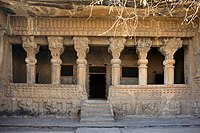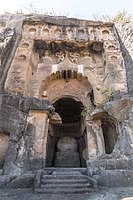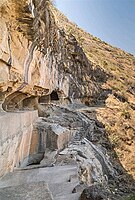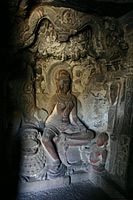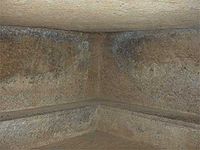Indian rock-cut architecture
| Art forms of India |
|---|
 |
Indian rock-cut architecture is more various and found in greater abundance in that country than any other form of rock-cut architecture around the world.[1] Rock-cut architecture is the practice of creating a structure by carving it out of solid natural rock. Rock that is not part of the structure is removed until the only rock left makes up the architectural elements of the excavated interior. Indian rock-cut architecture is mostly religious in nature.[2][3]
There are more than 1,500 known rock-cut structures in India. Many of these structures contain artwork of global importance, and most are adorned with exquisite stone carvings. These ancient and medieval structures represent significant achievements of structural engineering and craftsmanship.[4] The effort expended often astonishes visitors, but seen from one aspect, a rock-cut structure is a decorated rock quarry; most of the stone removed was typically put to economic use elsewhere.[citation needed]
In India, caves have long been regarded as sacred places. Caves that were enlarged or entirely man-made were believed to be as sacred as natural caves. The sanctuary in all Indian religious structures, even free-standing ones, was designed to have the same cave-like feeling, as it is generally small and dark, without natural light.
Historically, artisans carried forward design elements from wood in their rock-cut temples: skilled craftsmen carved rock to imitate timber texture, grain, and structure. The earliest cave temples include the Bhaja Caves, the Karla Caves, the Bedse Caves, the Kanheri Caves, and some of the Ajanta Caves. Relics found in these caves suggest a connection between the religious and the commercial. Buddhist missionaries are known to have accompanied traders on the busy international trading routes through India. Some of the more sumptuous cave temples, commissioned by wealthy traders, included pillars, arches, and elaborate facades. They were made during the period when maritime trade boomed between the Roman Empire and south-east Asia.[6]
Although free-standing structural temples were being built by the 5th century, rock-cut cave temples continued to be built in parallel. Later rock-cut cave architecture became more sophisticated, as in the
Early natural caves
The earliest caves used by humans were natural caves that they occupied or used for a variety of purposes, such as shrines and shelters. Evidence suggests that the caves were first occupied and slightly altered during the
During the time of the
Artificial caves of Eastern India (3rd–2nd centuries BCE)
In the 3rd century BCE Indian rock-cut architecture began to develop, starting with the already highly sophisticated and state-sponsored
There is another cave with the structure and polishing qualities of the Barabar caves, but without any inscription. This is the Sitamarhi Cave, 20 km from Rajgir, 10 km south-west of Hisua, also dated of the Maurya empire. It is smaller than the Barabar caves, measuring only 4.91x3.43m, with a ceiling height of 2.01m. The entrance is also trapezoidal, as for the Barabar caves.[23]
Finally, the
To the southeast of
-
Entrance of the Gopika cave, Barabar Caves, 3rd century BCE.
-
Polished interior of Sudama, in the Barabar Caves, 3rd century BCE.
-
Visvakarma cave entrance, Barabar Caves, 3rd century BCE.
-
Udayagiri and Khandagiri Caves, 2nd century BCE.
Artificial caves of Western India
After the Barabar Caves, huge efforts were made at building religious caves in Western India until the 6th century CE. However, the polishing of cave walls was abandoned, never to be revived. Such grandiose caves as Karla Caves (1st century CE) or the Ajanta Caves (5th century CE) do not have any polishing either. This may be due to the fact that Mauryan caves were dedicated and sponsored by the Mauryan Imperial government, allowing for huge resources and efforts to be spent, whereas later caves where essentially the result of donations by commoners, who could not afford as high a level of spending.[27]
First wave of construction (2nd century BCE–4th century CE)
Probably owing to the 2nd century BCE fall of the
When
Early examples of rock-cut architecture are the Buddhist and
-
Ezhadippattam, Sittanavasal Cave, 1st century BCE
-
Gautamiputra vihara atPandavleni Caves built in the 2nd century CE by the Satavahana dynasty.
-
Manmodi Caves in Junnar, 2nd century CE.
-
Tulja Caves in Junnar.
-
Pandavleni Caves.
Second wave of cave construction (5th–6th century CE)

The construction of caves would wane after the 2nd century CE, possibly due to the rise of Mahayana Buddhism and the associated intense architectural and artistic production in Gandhara and Amaravati.[20] The building of rock-cut caves would revive briefly in the 6th century CE, with the magnificent achievements of Ajanta and Ellora, before finally subsiding as Hinduism replaced Buddhism in the sub-continent, and stand-alone temples became more prevalent.[20][22]
The
Later many
-
Therock-cutBuddhist cave monument built under the Vakatakas.
-
Some of the 29 Ajanta Caves
-
A monastery, orvihara, with its square hall surrounded by monks' cells. Ajanta Caves, no. 4.
-
Neminath at a Jain Caveat Ellora
Rock-cut architecture also developed with the apparition of stepwells in India, dating from 200 to 400 CE.[35] Subsequently, the construction of wells at Dhank (550–625 CE) and stepped ponds at Bhinmal (850–950 CE) took place.[35]
Final wave of cave construction (6th–15th century CE)
At Ellora, on the hill to the northeast of the main complex of caves, is a Jain cave temple containing a 16-foot (4.9 m) rock-carved image of Lord Parshvanath with an inscription dated 1234/5 CE. This well preserved image is flanked by Dharaıendra and Padmavati, is still under active worship. The inscription mentions the site as Charana Hill, a holy site.[36] This was the last excavation at Ellora. The Ankai Fort caves are thought to be from the same period.
The final wave of Indian rock-cut cave construction occurred at Gwalior with five clusters of rock-cut monuments surrounding the
South-West Group: Now termed Trishalagiri.[37] The group is the first one encountered when driving to the Urvai Gate, just outside the fortifications. There are the oldest Jain monuments in Gwalior from the post-Gupta period. Archaeologist L.B. Singh dates them to 6th to 8th cent AD.[38]
South-East Group (Popularly referred to as Ek Patthar Ki Bawadi group or "
Babur, who visited Gwalior in AD 1527, ordered the Gwalior statues to be destroyed.[39] However, only the faces of many of colossal Jain images were destroyed, some of them were later repaired by the local Jains.
-
Jain statues, Siddhachal Caves
-
Jain Tirthankar statue,Gopachal
-
Image ofSamanar Malai, 9th century
-
Tirumalaicave temple
Monolithic rock-cut temples
-
Varaha Cave Temple 7th century
-
Jain cave 30 at Ellora
-
Pancha Rathas monolith rock-cut temples, late 7th century
The
A rock cut temple is carved from a large rock and excavated and cut to imitate a wooden or masonry temple with wall decorations and works of art.
There is no timeline that divides the creation of rock-cut temples and free-standing temples built with cut stone as they developed in parallel. The building of free-standing structures, especially Buddhist temples, began in the 3rd century BCE, whereas Hindu temples started to be built from the 5th century CE.[44] Meanwhile, rock cut temples continued to be excavated until the 12th century.
Stepwells

The stepwell is a large hole in the ground with steps at one or more sides. They are used in India to collect and conserve water from the
Gallery
-
Jain Badami cave
-
Entrance of Rockcut cave temple (Similar style as Barabar Caves) at Guntupalle, Andhra Pradesh
-
Advanced beds in earlyviharas at Kanheri Caves
-
Rock cut stair leading to Kanheri
-
Guntupalle Rockcut Caves, Andhra Pradesh
-
Rock cut Buddha statues, Bojjannakonda
-
View of large Rock cut stone Stupas at Lingalakonda, Andhra Pradesh
Rock-cut monuments in India
- Aihole has 3 Jaina temple
- Aurangabad Caves
- Badami Cave Temples
- Bagh Caves
- Elephanta Caves
- Jain temples.[46]
- Gopachal rock cut Jain monuments, Gwalior
- Kanheri Caves
- Lenyadri Caves
- Mahabalipuram
- Pancha Rathas
- Kazhuku Malai
- Pandavleni Caves
- Pitalkhora
- Undavalli caves, Andhra Pradesh
- Varaha Cave Temple at Mamallapuram
- Masroor Temple at Kangra
- Bojjannakonda Buddhist Site, Andhra Pradesh
- Guntupalle Buddhist Site, Andhra Pradesh
- Ramatheertham, Andhra Pradesh
- Gommateshwara statue, Shravanabelagola
See also
- Cave research in India
- List of Caves in India
- List of rock-cut temples in India
- Rock relief
- New Seven Wonders of the World
- List of archaeological sites sorted by country
- List of colossal sculpture in situ
- List of megalithic sites
Notes
- ^ "History of Architecture – Early civilizations". historyworld.net. Retrieved 2006-12-18.
- ^ Kamiya, Takeo. "Introduction to Indian Architecture". indoarch.org. Archived from the original on 2006-11-06. Retrieved 2006-12-18.
- ^ Nangia, Ashish. "Indian Rock-cut Architecture by Ashish Nangia". www.boloji.com. Archived from the original on 2010-01-14. Retrieved 2009-10-17.
- ^ "10 most amazing ancient rock cut structures in India". Wondermondo. 10 October 2011.
- ^ ISBN 0-226-53230-5.
- ISBN 0-8021-3797-0.
- ISBN 81-7039-218-7.
- ^ Ganvir, Shrikant. Newly Discovered Buddhist Rock-cut Caves of Maharashtra: An Appraisal. Archived from the original on 2020-04-03. Retrieved 2020-01-17.
- ^ "Prehistoric Rock Art". art-and-archaeology.com. Retrieved 2006-10-17.
- ISBN 9788170171935.
- ISBN 9788176250863.
- ^ Rock Shelters of Bhimbetka (PDF). UNESCO. 2003. p. 16.
- ISBN 9781780222592.
- ISBN 9780875864846.
- ^ ISBN 978-1-118-97228-1.
- ^ Jules Barthélemy Saint-Hilaire (1914). The Buddha and His Religion. Trübner. pp. 376–377.
- ^ Digha Nikaya 16 Archived 2018-08-31 at the Wayback Machine, Maha-Parinibbana Sutta, Last Days of the Buddha, Buddhist Publication Society
- ISBN 978-81-208-0805-8.
- .
- ^ a b c d e f Buddhist Architecture, Lee Huu Phuoc, Grafikol 2009, pp. 97–99
- ^ Ashoka in Ancient India by Nayanjot Lahiri p. 231 Archived 2022-11-23 at the Wayback Machine
- ^ a b Chandra, Pramod (2008), South Asian arts, Encyclopædia Britannica.
- ^ a b Gupta, The roots of Indian Art, p.194-
- ^ Bhargava 2006, p. 357.
- ^ Krishan & Tadikonda 1996, p. 23.
- ^ Pandya 2014, p. 6.
- ^ Le Huu Phuoc, Buddhist architecture, p.99
- ^ "World Heritage Site – Ajanta Caves". Retrieved 2007-04-12.
- ^ "Ajanta Caves". Archived from the original on 2007-04-04. Retrieved 2007-04-12.
- ^ Buddhist architecture, Lee Huu Phuoc, Grafikol 2009, p.98-99 Archived 2022-11-23 at the Wayback Machine
- ^ a b c "Architecture of the Indian Subcontinent – Classification of Indian Architecture through the Ages". www.indoart.org. Archived from the original on 2006-12-11. Retrieved 2007-06-26.
- ^ "Ajanta". Archived from the original on April 21, 2000. Retrieved 2006-12-21.
- ISBN 0-7946-0011-5.
- ^ "Badami (Western Chalukya)". art-and-archaeology.com. Retrieved 2006-12-21.
- ^ a b Livingston & Beach, xxiii
- ^ Lisa Nadine Owen, Beyond Buddhist and Brahmanical Activity: The Place of the Jain Rock-Cut Excavations at Ellora, PhD thesis 2006, University of Texas at Austin p. 255
- ^ "गोपाचल का त्रिशलगिरि समूह | Webdunia Hindi". hindi.webdunia.com. 2007-08-11. Retrieved 2021-07-21.
- ^ L. B. Singh, Puratattva, May 2005
- ^ Gwalior Fort: Rock Sculptures, A Cunningham, Archaeological Survey of India, pp. 364–370
- ISBN 81-7039-218-7.
- ^ "Monuments of India". Retrieved 2006-12-21.
- ^ "Kailash Rock Cut Temple". Archived from the original on 2007-01-18. Retrieved 2007-01-26.
- ^ "Ellora UNESCO World Heritage Site". Retrieved 2006-12-19.
- ^ Le Huu Phuoc, Buddhist Architecture, pp. 233–235
- ^ "Ellora Caves". Encyclopædia Britannica. Retrieved 2006-12-21.
References
- Bhargava, Gopal K. (2006). Land and People of Indian States and Union Territories: In 36 Volumes. Orissa, Volume 21. Gyan Publishing House. ISBN 9788178353777.
- Dehejia, V. (1972). Early Buddhist Rock Temples. Thames and Hudson: London. ISBN 0-500-69001-4.
- Fergusson, James (1864). The Rock-Cut Temples of India. John Murray, London.
- Krishan, Yuvraj; Tadikonda, Kalpana K. (1996), The Buddha Image: Its Origin and Development, Bharatiya Vidya Bhavan, ISBN 9788121505659
- Pandya, Prashant H. (2014), Indian Philately Digest, Indian Philatelists' Forum
- Rajan, K.V. Soundara (1998). Rock-Cut Temple Styles. Somaiya Publications: Mumbai. ISBN 81-7039-218-7
External links
- Photos of rock-cut Bhaja cave
- India rock cut Temples Study Project and Photos of Sculpture
- History of Architecture Site
- Architectural Styles
- New York Times article 'Rock-cut temple of the many faced God', August 19, 1984
- St. Olaf College Art Course Handouts Archived 2007-09-29 at the Wayback Machine
- Ellora Caves UNESCO World Heritage Site
- Lycian Influence to the IndianCave Temples
- Group of Monuments at Mahabalipuram UNESCO World Heritage Site
- Elephanta Caves UNESCO World Heritage Site
- UNESCO World Heritage: Rock Shelters of Bhimbetka
- Indian rock cut temples
- In the Holy Caves of India
- Kailesh Rock Cut Temple Archived 2007-01-18 at the Wayback Machine
- Kerala Temple Architecture
- Pallava Art and Architecture
- Cave architecture
- The rock-cut temples of western India
- Articles on Early and Later Western Indian Caves Part 1 (Early) and Part 2 (Later)







